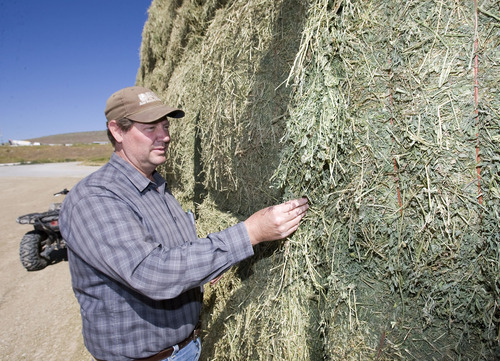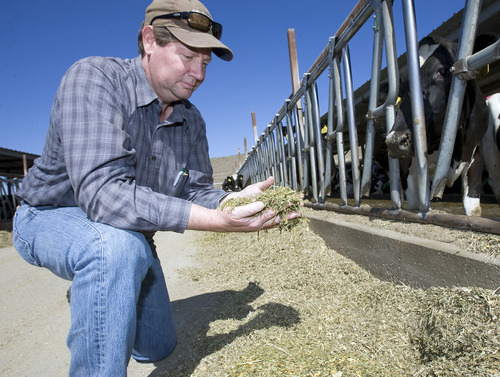This is an archived article that was published on sltrib.com in 2011, and information in the article may be outdated. It is provided only for personal research purposes and may not be reprinted.
The cold, wet spring has been all too familiar for Elberta dairy farmer Brad Bateman.
The season brings to mind last year's ruinous rains, which damaged much of the alfalfa crop and forced producers to ship in higher-priced hay from other states or purchase lower-quality feed locally.
"This cold, wet spring is bringing us back to last year's scenario," said Bateman, who also grows alfalfa. "If we don't get some warm weather, we'll be looking at back-to-back bad years."
Bateman is two weeks behind his first alfalfa cutting, and yields are lower than normal.
In a typical season, growers can get three to four cuttings of hay. But June is the most important month, when about half the crop is harvested. Yields are substantially lower with each additional cutting.
The first hay cutting is in full swing in Utah County, the state's No. 1 spot for total farm revenue. In Box Elder County, many acres of hay sustained minor to moderate rain damage. Producers are trying to cut hay early to allow fields enough time to grow before the second cutting. And in Uintah County, yields are below normal, according to the Agricultural Statistics Service.
Cache County producers are seeing high numbers of alfalfa weevils, a major pest in Utah. Weevils can thrive after late frosts, which can delay alfalfa growth, giving pests time to infest the crop. Some growers are delaying harvests as they spray insecticides, while others are hoping to cut hay as soon as possible. Still other growers are cutting hay because they are out of feed for their cattle, according to the weekly report.
This spring, Neal Briggs, who grows about 300 acres of alfalfa in Syracuse, was hoping the weather would be warmer than last year. Instead, temperatures plummeted, reducing production by half.
"Hay doesn't like cold weather," he said. "It takes heat units to grow a crop, and we've been short on heat units this year."
Farmers have been contending with cooler, wet weather. Spring temperatures were 10 degrees to 15 degrees lower than normal — and it's been the wettest period since 1875, according to the National Weather Service.
If higher temperatures hold, growers may get a final, fourth cutting, said Kerry McBride, deputy director of the Agriculture Service. But at this point, "we don't know for sure if this will be another bad year. Production has been down for the previous two years."
Alfalfa production fell to 2.16 million tons last year, down from 2.22 million tons the year before — compared with 2008, when production topped 2.31 million tons.
It's difficult to determine the price of hay because supplies are so short, said Rulon Fower, a grower and broker in Weber County. He has sold dairy-quality hay from Millard County, the state's top producer, at $200 a ton.
Intermittent rains are keeping growers from drying hay. Some dairies are using green, chopped alfalfa, but cows need dry matter, "so that's only a short-term fix," he said. "I've held off cutting my own hay until I can get some dry days. Now I have no choice but to cut, even if it means lower-quality hay."
This year's heavy rains have stunted other crops, as well.
Stripe rust has affected more than 1,000 acres of wheat in Box Elder County. Dryland farmers, unable to plow because of the wet soil, are spraying herbicides on the wheat stubble to stay ahead of weeds. The Statistics Service also reports that Weber County growers are planting corn five weeks late, which could mean up to a 30 percent reduction in yields.
Frost damage to wheat has been reported in San Juan County, with low areas and draws sustaining the most damage. It's estimated that about a quarter of the county wheat acreage has been hit.
The weather is also affecting livestock.
Livestock producers in Box Elder and Utah counties are moving cattle and sheep to summer ranges. But officials say there will be delays because of lingering snow pack at higher elevations.
In addition, flooding has been reported in Uintah, Wayne, Emery and Weber counties. The Green, Price and Weber rivers in some areas are at or above flood stage. Overall, range and pasture conditions are good in areas that haven't been flooded.
dawn@sltrib.comTwitter: @DawnHouseTrib —
Utah hay
Record production year • 1999, at 2.42 million tons
Last year's production • 2.16 million tons
Worst production year • 1934, at 600,000 tons
U.S. ranking for alfalfa production • 14
National ranking for all hay • 23
Source: U.S. Department of Agriculture —
Alfalfa is state's No.1 cash crop
Annual farm receipts • $182 million
Alfalfa price • $175 to $200 per ton
Top alfalfa counties (in order) •Millard, Iron, Cache, Iron, Box Elder and Sanpete
Source: Utah Department of Agriculture and Food











